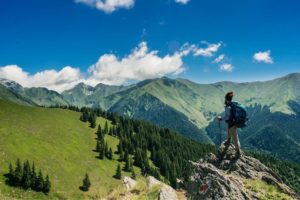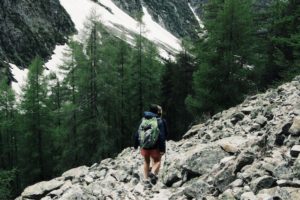When hiking in certain areas, you must have the right pass to access the trails and enjoy the natural beauty.

In the Northwest region, hikers use two common passes: the Northwest Forest Pass and the Discover Pass.
In this article, we’ll compare and analyze both passes in detail to help you make the right call, so let’s dive right in.
Hiking in Northwest Forest Pass vs. Discover Pass: 12 Differences
To make the right decision, let’s compare the Northwest Forest Pass and the Discover Pass in great detail.
Cost
Both passes come with a cost. The Northwest Forest Pass is priced at $30 per vehicle for an annual pass or $5 per day for a daily pass.
On the other hand, the Discover Pass costs $30 per vehicle for an annual pass or $10 per day for a daily pass.
From a cost perspective, the Northwest Forest Pass is more economical for hikers planning frequent visits, while the Discover Pass is a better choice for occasional hikers.
Coverage
The Northwest Forest Pass gives access to designated recreational sites and trailheads managed by the U.S. Forest Service and the Bureau of Land Management in the Pacific Northwest region.
It primarily covers national forests and some scenic areas.
In contrast, the Discover Pass allows entry to state parks, state wildlife areas, and other state-managed recreation lands across Washington state.
If your hiking adventures involve state parks or wildlife areas, the Discover Pass is the preferred option.
Accessibility
Regarding accessibility, the Northwest Forest Pass is readily available at Forest Service offices, visitor centers, and numerous retail locations. It can also be purchased online.
The Discover Pass can be obtained online, by phone, or in person at authorized vendors. Both passes offer multiple ways to acquire them, ensuring convenience for hikers.
Validity Period
The Northwest Forest Pass operates on an annual basis, allowing hikers to enjoy unlimited access for a full year from the date of purchase.
The Discover Pass, too, is valid for a year, providing ample time for hikers to explore the state’s parks and recreational lands.
In terms of validity, both passes offer extended access and flexibility.
Flexibility of Use
When it comes to flexibility, both the Northwest Forest Pass and the Discover Pass have their advantages.
With the Northwest Forest Pass, you establish ownership by signing it. The pass includes spaces for the signatures of the two household members who will use it the most.
The interesting part is that all members of the household can use the pass, no matter who signed it. This means that everyone in the household can benefit from it.
The Discover Pass also offers some flexibility, particularly regarding usage with multiple vehicles. It can be transferred between two vehicles by writing down their license plate numbers on the pass.
However, note that the Discover Pass can only be used in one vehicle at a time. Duplicating the pass and using it simultaneously in multiple vehicles is not allowed.

Additional Recreational Activities
Consider whether you engage in activities beyond hiking, such as fishing, boating, or picnicking.
The Northwest Forest Pass covers trailhead parking for hiking purposes, but additional fees may be required for certain recreational activities like fishing or boat launches.
On the contrary, the Discover Pass includes access to a wide range of state parks and recreational lands where you can enjoy various activities beyond hiking, often without additional fees.
If you plan to partake in multiple recreational activities during your visits, the Discover Pass offers a more comprehensive option.
Scenic Beauty and Wilderness Access
If you seek to explore more remote and wilderness areas, the Northwest Forest Pass might be more appealing.
It provides access to national forests and some less-developed scenic spots managed by the U.S. Forest Service and the Bureau of Land Management.
These areas often offer a quieter and more pristine hiking experience.
Conversely, the Discover Pass focuses on state parks and recreation lands, which typically have more developed facilities, including amenities like picnic areas, restrooms, and visitor centers.
If you prefer a blend of nature and convenient facilities during your hikes, the Discover Pass is better suited.
Community and Events
Consider the presence of organized events, festivals, or community gatherings within the areas covered by each pass.
State parks managed under the Discover Pass often host community events, educational programs, and seasonal festivals that might enhance your hiking experience with additional attractions and entertainment.
If you enjoy being part of such community events or want to explore beyond hiking alone, the Discover Pass could provide a more vibrant atmosphere.
Visitor Demographics and Crowds
Consider the popularity and visitor demographics of the areas covered by each pass. The Northwest Forest Pass attracts various outdoor enthusiasts, including avid hikers, nature photographers, and wilderness explorers.
Due to the vastness and varied landscapes of national forests, you may encounter fewer crowds and have more opportunities for solitude in the wilderness.
On the other hand, state parks covered by the Discover Pass often cater to a wider audience, including families, campers, and day-trippers.
If you prefer a quieter and less crowded hiking experience, the Northwest Forest Pass might be preferable.
Environmental Initiatives and Conservation Efforts
Evaluate the environmental initiatives and conservation efforts associated with each pass.
The Northwest Forest Pass supports the U.S. Forest Service and the Bureau of Land Management in their ongoing efforts to preserve and maintain national forests and scenic areas.
By purchasing this pass, you contribute directly to the conservation and sustainable management of these natural landscapes.
The Discover Pass, on the other hand, aids in funding Washington state parks, wildlife areas, and other recreational lands, supporting their conservation and recreational programs.
If you have a particular affinity for national forests or state parks and want to contribute to their preservation, choose the pass that aligns with your conservation values.

Distance and Proximity to Hiking Locations
Consider the distance and proximity of the areas covered by each pass to your location.
If you reside closer to national forests or scenic areas managed by the U.S. Forest Service, obtaining the Northwest Forest Pass may be more practical and cost-effective.
On the contrary, if state parks and recreation lands under the Discover Pass are closer and more easily accessible, it makes sense to opt for that pass.
Parking Availability and Regulations
Consider the parking availability and regulations associated with each pass.
With the Northwest Forest Pass, you can access designated trailhead parking areas within national forests and scenic spots. They’re often well-maintained and offer ample space for hikers.
However, be aware of specific parking restrictions or requirements in certain areas, such as limited parking hours or seasonal closures.
The Discover Pass provides access to parking areas within state parks and recreation lands.
State park parking areas generally have well-marked spaces and facilities, but it’s advisable to check for parking restrictions, such as day-use parking fees or time limits.
Happy Hiking!
In summary, the choice between the Northwest Forest Pass and the Discover Pass depends on individual needs and preferences.
If you frequently explore national forests and specifically designated sites, the Northwest Forest Pass offers affordability and complete access.
However, if your hiking adventures extend to state parks and wildlife areas, the Discover Pass is the more suitable option.
Consider your hiking habits, preferred locations, and frequency of visits when making a decision.

I was working as a mountain guide, probably all around the planet. One day, I met my wife in the mountains, literally on top of the world. Now, I have a beautiful family and three kids, so I don’t have much time for climbing, but sometimes I go camping with my friends. I am also into gym workouts, and I can’t imagine my life without sports.
Since I ended my professional career as a climbing guide, I’ve been giving personal classes and helping amateurs to get ready for conquering their first peaks. Also, that’s how the whole blog idea appeared.





